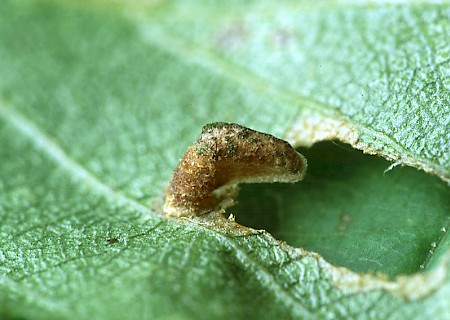Coleophora serratella

37.015 BF493
Coleophora serratella
(Linnaeus, 1761)
Wingspan 11-14 mm.
This is probably the commonest species of British Coleophorid, and is found throughout the British Isles wherever its foodplants grow.
The adult, which appears in June, resembles several other grey-brown Coleophora species. The indistinct rings near the tip of the antenna distinguish it from some of them, but examination of the genitalia is advised for positive identification of non-reared specimens.
The larva feeds by inserting its head into small mines it creates on the leaves of birch (Betula), elm (Ulmus), alder (Alnus), or hazel (Corylus). Occasionally it is found feeding on other trees, or on herbaceous plants onto which it has accidentally fallen.
Pupation, June - early July, is in the larval case fixed to the upper surface of a leaf in a sunny situation. Sometimes pupation is on plants other than those fed on.
For larval details, please click 'show detail', below
Larva: (description Ian F. Smith)
Larval case:
It forms two cases during its larval life. The first case is initially curved, smooth, laterally compressed with a bivalved anal opening, and about 2mm long in September. During October it feeds, and adds a few rough collars of larval material around the oral opening. After hibernation, it feeds again in April and early May, adding more protruding collars until they equal or exceed the original smooth part of the case. At the same time, it expands the case girth by the creation of a silk gusset ventrally.
The second case, 6 or 7 mm long, is formed in May, leaving the vacated first case attached to its last feeding mine. The new case is tubular with a trivalved crimp at the anal opening. The dorsum is formed from the edge of the leaf from which the case was cut. This results in a more or less serrated dorsal keel, depending on the plant species and the individual piece of leaf used. Considerable variation in the degree of serration can be found, even among specimens off the same tree. The case colour varies with food plant, from yellowish brown on birch, darkening through elm and hazel to dark brown on alder.
Foodplants: September - early June. Mainly Betula, Ulmus, Alnus, or Corylus. Also reported on Carpinus, Sorbus, Malus and Salix. Occasionally feeding on herbaceous plants below these trees.
Length: 4.5 mm described in late May.
Head: Black.
Prothoracic shield: Black, divided by brown medial line. Small lateral sclerite.
Mesothorax (T2): Two small, but distinct, black dorsal sclerites. Small lateral sclerite.
Metathorax (T3): No dorsal sclerites. Small lateral sclerite.
Body: Burnt ochre.
Anal plate: Black.
Prolegs: Three pairs of ventral prolegs.

 UKMoths
UKMoths 










